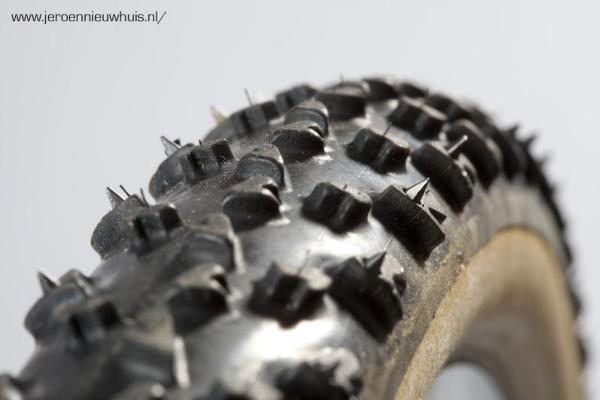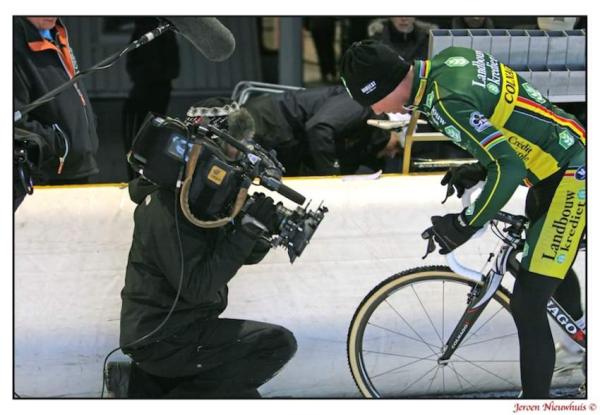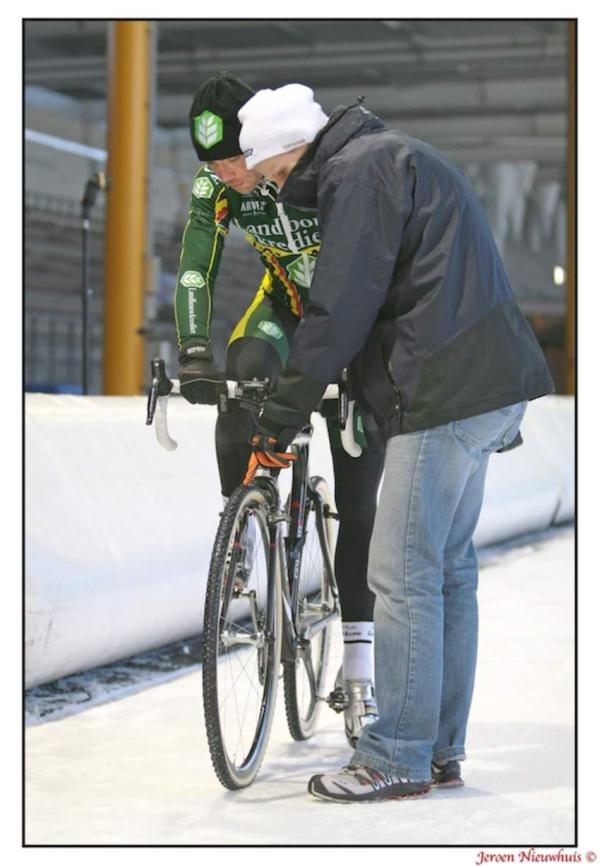Banned: Nys tests Dugast's Diavolo spiked tyre on ice
UCI bans 'cross tyre before it's even raced on





Diavolo could have been the Dugast tyre that turned the tables during the recent cyclo-cross world championships, had the International Cycling Union (UCI) allowed it. The spiked tyre was the latest ‘course specific’ development to come from the brand. And it's one that — even without seeing competitive use — will further its legend.
The tyre was built specifically for the icy conditions expected at the world championships in Tabor, Czech Republic. Just by looking at it, a savvy rider can see its advantage for grip on an icy course. In testing, at an ice rink in Eindhoven, The Netherlands, Belgian champion Sven Nys is said to have ridden 45 kilometers per hour on pure ice using the tyre.
When directly compared to a normal Dugast tubular tyre in a straight run, the standard tubular would slip at between 190 and 210 watts, while the Diavolo could handle over 950 watts before breaking free, according to Dugast. This was measured using an SRM power meter.
“They would have made a huge difference in Tabor,” said Stu Thorne, owner of Dugast USA. Thorne's Cannondale-cyclocrossworld.com team was due to receive one of the 25 sets of Diavolos that Dugast owner Richard Nieuwhuis made for the world's.
But the UCI spiked any chance that the tyre could be used. For the simple reason that it, er, featured studs.
“They knew that they’d have trouble with the stud, as it’s worded,” said Thorne. “He [Nieuwhuis] seemed to think that because it had some movement to it, it wasn’t considered a stud. It was basically semantics as to what you perceived a stud to be.”
The UCI’s rules clearly outline a ban on spikes or studs in section 1.3.018: Wheels of the bicycle may vary in diameter between 70 cm maximum and 55 cm minimum, including the tyre. For the cyclo-cross bicycle the width of the tyre shall not exceed 35 mm and it may not incorporate any form of a spike or stud.
The latest race content, interviews, features, reviews and expert buying guides, direct to your inbox!
Nieuwhuis ended up showing the tyre to the UCI so as not to risk a rider being disqualified should they use it in Tabor. Predictably, the UCI banned it. He maintains, however, that design of the tyre allows the sharp pins to move within the tread’s knobs, from 0.1mm to 0.5mm, so they weren’t dangerous, or that’s how he had hoped the UCI would see it.
“It’s quite simple, spikes and studs are either fixed or based with glue or a thread,” Nieuwhuis told us. “This needle that is moving up and down. It is not fixed. So due to that, you cannot file it under the rule that it’s a spike, when a spike is fixed.”
"I understand there is what I call a ‘grey area,’ but the thing that I don’t understand is that almost everyone that was on the track, was once or twice on the ground due to the front or rear wheel slipping away. If you fall on the frozen ground, that can hurt you as well. [Diavolo] is not going to hurt you. It’s not going to rip you open; it’s not going to be like ice speedway racing or something.”
It is said that a single Diavolo tyre takes six hours to make and it uses the Rhino tread as a base. The movable pin system was co-developed with HJZ, a Dutch nail manufacturer, and took three months to design. Nieuwhuis knew that if he only made tyres for his athletes, a ban was certain, so he took a different tactic and produced 50 of the special Diavolo tyres. He had planned to give two to every country competing at world’s in Tabor.
“It’s not something that I would have kept only in the pocket of Sven Nys and Marianne Vos and that was it,” he said.
The Dugast legend
This isn’t the first time Dugast has made waves with an event specific tyre. The legend started when Richard Groenendaal rode a custom set of Dugast casings with Michelin green Mud treads fixed to them, a concept whose popularity paved the way for Dugast’s own Rhino. Interestingly, this unveiling also took place at world’s in Tabor, but in 2001.
The legend grew the following year with another tyre for Groenendaal, this time egg shaped tyre developed for the Zolder world’s course. Fable has it that the racer could inflate and deflate the tyres on command. In reality, the tall oval shaped casing, which measured 35mm in height and 32mm in width, kept the tyre up high in its efficient center on the power-sucking track but gave ample traction when it conformed to the dirt.
2003 World’s in Monopoli, Italy gave way to 10 pairs of 'unflattable' tyres made with extra latex and track tyre treads affixed to its sidewalls, which make them virtually cut proof. The design took four world championship titles and Sven Nys famously refused to pay for saying he could buy four camper tyres for the same price. Needless to say he did not win that year, instead, Bart Wellens paid for the special tyres and won the elite race.
The list goes on: The stiff casing developed for Pont-Château, France’s fast course could handle lower pressures without folding and would eventually morph into the Flying Doctor casing that Dugast offers for sale. Now, we must add the Diavolo’s needles to Dugast’s special list.
“For me as a manufacturer, its more than just business, it’s much, much more,” said Nieuwhuis. “I look at it from a different standpoint. I do that with pleasure. You have to understand that this guy [world champion, Zdenek Stybar] is putting 40 hours per week training on his bike. He leaves his mother, his father and family in the Czech Republic and goes to Belgium and lives there, but if the weather conditions are not good enough to train he takes the first plane 1000kms south to Spain to train. If somebody is going to put so much effort into the sport it means that everybody that does something for his bike should make the same effort.
"It’s a passion for the sport.”
It’s clearly Nieuwhuis’ passion that will continue the legendary legacy of Dugast tyres.
